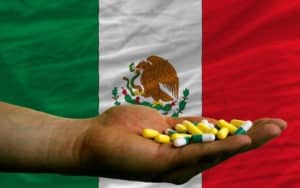Clinical Trials in Mexico: Addressing the Challenges
Western Europe are encountering various challenges in clinical trials research, ranging from high costs to inadequate patient recruitment rates. This has resulted in a growing trend to transfer clinical research into newly emerging regions of the world.

One reason is that Mexico has the second largest population in Latin America—approximately 110 million, according to the 2008 CIA World Factbook.2 Of this number, 70% reside in Mexico City—the most densely populated city in the world—allowing for excellent patient recruitment rates. In addition, Mexico’s lower cost for clinical research has made it particularly attractive for clinical trial outsourcing. Another factor that has helped to boost Mexico’s economy and increase foreign pharmaceutical investment is the North American Free Trade Agreement (NAFTA), signed in 1993. Economic and political stability have encouraged many local and global CROs to establish expertise in the management of clinical trials in Mexico. Healthcare reforms have improved healthcare coverage among uninsured patient populations. However, in order to fully benefit from the advantages offered by outsourcing clinical research to Mexico, a better understanding of the people and the factors that affects clinical research the advantageous and disadvantages of conducting clinical trials in Mexico.
Regulatory Approval and Informed Consent
Despite efforts by the Mexican government to streamline the process, Mexico continues to have one of the lengthiest and often slowest moving regulatory approval systems.3 According to Kendle, a CRO specializing in clinical trial management that operates in Mexico, average approval times range from 14 to 16 weeks. Regulations in Mexico, however, have evolved considerably, and current legislature requires that clinical research meets with ICH-GCP standards.
The Regulation of General Law and Health for Research on Health Related Topics, issued in 1986, regulates all scientific and technological research developed in the healthcare sector. In addition to ethics committees and investigational review boards (IRBs), approval must be obtained from the national Ministry of Health. 4 There are two steps for authorization: initial approval by an ethics committee, followed by a regulatory review. Prior to initiating clinical trials, approval must be received from a local IRB, the regulatory body, and the director at each site. Moreover, in order to protect the rights of certain vulnerable subject groups, there are specific laws regarding clinical trial protocols for human subjects in selected communities, including women, children elderly, handicapped, and indigenous populations.
Regulatory delays in clinical trials are most commonly due to problems with informed consent. This is partly because many sponsors are not fully aware of the significant literary, linguistic and cultural barriers that exist among many clinical subjects in Mexico. Although Mexican regulations follow informed consent procedures that are recommended by international standards for pharmaceutical companies with US FDA approval, most Mexican health institutions ask subjects to sign a second consent form. This form, in addition to being written in simple language, must contain the complete data and signatures of two witnesses, specifying their relationship to the patient. Although this procedure has been adopted to help eliminate ethical issues that may interfere with obtaining informed consent among less educated populations,7 several issues remain.
Poverty, Illiteracy, and Indigenous Populations
Poverty and illiteracy are important factors to consider when enrolling subjects for clinical trials, particularly in a developing country like Mexico. In 2002, half the population of Mexico was reportedly living in poverty and one-fifth in extreme poverty. Around one quarter of people who live in extreme poverty reside in the urban areas of Mexico’s central and southern states.8 Although Mexico is the currently the world’s 13th largest economy, close to 40 million of its approximately 110 million citizens live below the Mexican poverty line. Illiteracy is another major issue. Different regional populations have varying percentages of illiteracy in Mexico. Although official figures indicate the national literacy rate is approximately 90%, according to INEGA Mexican Research Institute statistics, in northern Chiapas, (the southernmost state of Mexico), close to 50% of adults are functionally illiterate.9
Mexico can be divided into three socioeconomic groups. The criollo minority of the upper and middle classes are of European origin and represent only 9% of the population. The economically poor mestizo majority comprises some 60% of the population and is a mix of European and native peoples. The extremely poor indigenous minorities live in central and southern Mexico; there are 36 million indigenous people in Mexico, of many different ethnic groups, which according to the 2008 CIA World Factbook constitute about 30% of the total population.2 Mexico City has the largest concentration of indigenous people in the entire country, due to an influx from migration.10 The state of Oaxaca, one of the poorest regions located in the southeast of Mexico, is one of the most highly diverse due to the presence of several indigenous populations.11 Ethnic diversity is important for two reasons. In addition to the cultural and language barriers presented by different ethnicities, genetic factors play a role in a patient’s biological response to a pharmaceutical product. More specifically, different genetic profiles among ethnic groups in Mexico may yield differences in clinical trial results. Therefore, biopharmaceutical products that are developed for the Mexican market should take genetic diversity into account.12
Mexican Spanish and Dialects in Clinical Trials
The differences between Mexican Spanish and Castilian Spanish from Spain are greater than those between American English and British English. These differences are largely due to the influence of native languages in Mexico. Currently, there are more than 50 spoken native Mexican languages that contribute to the diversity of Spanish dialects found in Mexico. For example, the Spanish of the Yucatan Peninsula incorporates several Mayan words and possesses a distinct regional pronunciation. The Spanish spoken in the areas that border Guatemala resembles the variation of Central American Spanish spoken in Guatemala. This is partly due to geographic barriers, such as mountainous regions, that separate various ethnic groups in Mexico and have allowed them to maintain their native languages and Spanish dialects.13
Mexico City, before becoming Mexico’s modern capital city, was the ancient capital of the Aztec Empire. Because Nahuatl (the native Aztec language) speakers outnumbered Spanish speakers for several generations after the Spanish conquest, the Mexican language evolved into what is now considered Mexican Spanish, incorporating many Hispanic Nahuatl words. In 1980, Mexico City registered 323,000 indigenous language speakers of 39 different languages.10 In addition, the state of Oaxaca is among the most linguistically diverse in Mexico due to its many indigenous groups.12 Although standard Mexican Spanish is understood by all, differences in usage and vocabulary among the various regions are common and can sometimes lead to misunderstandings. Dialects vary depending on the individual’s education, socioeconomic level, and ethnic background. These distinctions must be taken into consideration in terms of how they affect clinical research.
Clinical Trials and Culture
Because patients’ medical attitudes are influenced by their culture, the cultural factors that influence clinical research must be identified. For example, cultural differences influence the patient-doctor relationship. Because Mexican patients are less likely to question the recommendations of their physician than patients in the US, their decision to participate in clinical trials is primarily a result of their physician’s recommendation. Although this facilitates the enrollment of patients into clinical trials and provides many patients with treatment that would not otherwise be available to them, the ethical implications must also be addressed. Another consideration is the effect of culture on medical practices. For example, sometimes indigenous populations enrolled in clinical trials in Mexico may not report their use of local herbal treatments. Such information needs to be investigated to avoid any potential interference of herbal medicines with the biopharmaceutical product undergoing testing. Indigenous groups of Mexico have long used herbal therapies, and often combine traditional herbal medicine with biopharmaceutical products. The problem arises, however, when participants fail to report their use. For example, one study revealed that Mexican-American women are three times more likely to use herbs than the general population and are less likely to report their use.14
Translation, Localization, and Recommendations
The importance of native language communication and localization strategies has been well established in global clinical trials. Spanish translation services of regulatory documents is best provided by a local, native speaker of Mexican Spanish who is a professional translator and has a background in clinical research. Professional translators, in addition to their knowledge of local linguistic differences, are familiar with the specific terminology used in clinical trial documents. In addition to life sciences translation, language must be culturally adapted to the Mexican patient population for which it is intended.
The Mexican pharmaceutical market is dominated by foreign companies and is attracting a lot of clinical research due to the advantages of conducting clinical trials there. In choosing clinical trial sites, however, taking the time to better understand the people in a particular region enhances patient recruitment and compliance, and ensures that ethical standards are maintained. The disparities in education and socioeconomic status, along with ethnic and linguistic differences that exist among various Mexican populations, must be considered in terms of how they affect clinical research. As the number of international pharmaceutical companies outsourcing clinical trials in Mexico increases, their success in conducting clinical research will depend on an awareness of these issues.
References
- S DeSantis. ‘inVentiv Clinical Moves into Latin America’, Clinical Trials Today, Thomson CenterWatch. March 24, 2008 (https://www.clinicaltrialstoday. com/2008/03/inventiv-clinic.html).
- Central Intelligence Agency. World Factbook, 2008. (https://www.cia.gov/library/publications/the-world-factbook/print/mx.html).
- S Gambrill. ‘Fighting the Logjam in Latin American Drug Trials’, Clinical Trials Today, Thomson CenterWatch, September 18, 2006 (https://www. clinicaltrialstoday.com/2006/09/fighting_the_ lo.html#more).
- A Herrera. ‘Conducting Clinical Trials for Medical Equipment’, International Market Research Reports, September 17, 2003 (https://strategis.ic.gc.ca/epic/site/ imr-ri.nsf/en/gr109880e.html).
- Latin American Vertebral Osteoporosis Study (LAVOS) IOF World Congress on Osteoporosis, June 4, 2006 (https://www.iofbonehealth.org/wco/2006/ newsletters/20060604-science-10/index.html).
- H King. ‘World Health: Global Burden of Diabetes 1995-2025’, Diabetes Care, 21:1414-1431, 1998.
- J Fiuza. ‘Strategies for Implementing Trials in Latin America’, EPC Clinical Development, 2006 (https:// www.pharm-olam.com/pdfs/EPC-Winter-2006-LA. pdf).
- Poverty in Mexico Fact Sheet. The World Bank Group, 2008 (https://web.worldbank.org/WBSITE/ EXTERNAL/COUNTRIES/LACEXT/MEXICOEXT N/0,,contentMDK:20233967~pagePK:141137~piPK:1 41127~theSitePK:338397,00.html).
- Mexico, Social and Economic Development for Indigenous Mexicans (DESMI), and K’inal Antzetik (Land of Women) (https://www.idex.org/country. php?country_id=4).
- J Schmal. History of Mexico, ‘The Linguistic Diversity of Mexico’, Houston Institute for Culture Educational literature, 2004 (https://www.houstonculture.org/mexico/ ling.html).
- C Marshall, G J Lourdes. ‘Learning from our neighbor: Women with disabilities in Oaxaca, Mexico – Women with disabilities in Mexico’, Journal of Rehabilitation, October 2002 (https://findarticles.com/p/articles/mi_m0825/is_/ ai_95105816).
- F Kermani. ‘Communique Mexico’s Potential’, Contract Services Europe, April/ May, 2005 (https://www3.chiltern.com/data/media/articles/23.pdf).
- J Schmal. ‘The Dialects of Mexico’, LatinoLa, February 23, 2003 (https://latinola.com/story.php?story=710).
- L Howell. ‘Use of herbal remedies by Hispanic patients: do they inform their physician?’, The Journal of the American Board of Family Medicine, 19, pp566-578 (https://www.jabfm.org/cgi/content/full/19/6/566).
About Language Connections:
Language Connections is one of the top language service companies in the US. Over the last 30 years, we’ve focused on providing the best business translation services, interpreting services, as well as interpreter training and customized language training programs. In addition to top-tier corporate language training, we offer certified corporate interpreters and professional business translation services in 200+ languages. Our network includes linguists with backgrounds in all major industries. They’re ready to meet your needs, whether they’re for technical translation services, legal translation, government translation services, international development translation services, education translation services, life sciences translation, or something else. Reach out to us today for a free quote on our cost-efficient and timely translation services, interpreters, or other linguistic services.
Language Connections Inc.
2001 Beacon Street, Suite 105,
Boston, MA 02135
Phone: +1-617-731-3510
Email: service@languageconnections.com







